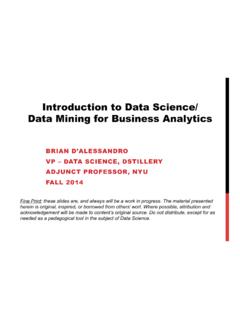Transcription of Covariance matrix - New York University Center for Data ...
1 Probability and Statistics for Data ScienceFall 2020 Covariance matrix1 The Covariance matrixTo summarize datasets consisting of a single feature we can use the mean, median and variance,and datasets containing two features using the Covariance and the correlation coefficient. Here weconsider datasets containing multiple features, where each data point is modeled as a real-valuedd-dimensional we model the data as ad-dimensional random vector, its mean is defined as the vector formedby the means of its (Mean of a random vector).The mean of ad-dimensional random vector xisE( x) := E ( x[1])E ( x[2]) E ( x[d]).
2 (1)Similarly, we define the mean of a matrix with random entries as the matrix of entrywise (Mean of a random matrix ).The mean of ad1 d2matrix with random entries XisE( X) := E( X[1,1])E( X[1,2]) E( X[1,d2])E( X[2,1])E( X[2,2]) E( X[2,d2]) E( X[d1,1])E( X[d1,2]) E( X[d1,d2]) .(2)Linearity of expectation holds also for random vectors and random (Linearity of expectation for random vectors and matrices).Let xad-dimensionalrandom vector, and letb RmandA Rm dfor some positive integerm, thenE(A x+b) =AE( x) +b.(3)Similarly let, Xbe ad1 d2random matrix , and letB Rm d2andA Rm d1for some positiveintegerm, thenE(A X+B) =AE( X) +B.
3 (4)Carlos Fernandez-Granda, Courant Institute of Mathematical Sciences and Center for Data Science, prove the result for vectors, the proof for matrices is the same. Theith entry ofE(A x+b) equalsE(A x+b)[i] = E ((A x+b)[i])by definition of the mean for random vectors(5)= E(d j=1A[i,j] x[j] +b[i])(6)=d j=1A[i,j]E ( x[j]) +b[i]by linearity of expectation for scalars(7)= (AE( x) +b)[i].(8)We usually estimate the mean of random vectors by computing their sample mean, which equalsthe vector of sample means of the (Sample mean of multivariate data).LetX:={x1,x2,..,xn}denote a set ofd-dimensional vectors of real-valued data.
4 The sample mean is the entry-wise average X:= ni=1xin.(9)When manipulating a random vector within a probabilistic model, it may be useful to know thevariance of linear combinations of its entries, the variance of the random variable v, x forsome deterministic vectorv Rd. By linearity of expectation, this is given byVar(vT x)= E((vT x E(vT x))2)(10)= E((vTc( x))2)(11)=vTE(c( x)c( x)T)v,(12)wherec( x) := x E( x) is the centered random vector. For an example whered= 2 and the meanof xis zero we have,E(c( x)c( x)T)= E( x xT)(13)= E([ x[1] x[2]][ x[1] x[2]])(14)= E([ x[1]2 x[1] x[2] x[1] x[2] x[2]2])(15)=[E( x[1]2)E( x[1] x[2])E( x[1] x[2])E( x[2]2)](16)=[Var ( x[1])Cov ( x[1], x[2])Cov ( x[1], x[2])Var ( x[2])].
5 (17)This motivates defining the Covariance matrix of the random vector as ( Covariance matrix ).The Covariance matrix of ad-dimensional random vector xis thed dmatrix x:= E(c( x)c( x)T)(18)= Var ( x[1])Cov ( x[1], x[2]) Cov ( x[1], x[d])Cov ( x[1], x[2])Var ( x[2]) Cov ( x[2], x[d])..Cov ( x[1], x[d]) Cov ( x[2], x[d]) Var ( x[d]) ,(19)wherec( x) := x E( x).The Covariance matrix encodes the variance ofany linear combinationof the entries of a any random vector xwith Covariance matrix x, and any vectorvVar(vT x)=vT xv.(20) follows immediately from Eq. (12).
6 Example (Cheese sandwich).A deli in New York is worried about the fluctuations in the costof their signature cheese sandwich. The ingredients of the sandwich are bread, a local cheese, andan imported cheese. They model the price in cents per gram of each ingredient as an entry in athree dimensional random vector x. x[1], x[2], and x[3] represent the price of the bread, the localcheese and the imported cheese respectively. From past data they determine that the covariancematrix of xis x= .(21)They consider two recipes; one that uses 100g of bread, 50g of local cheese, and 50g of importedcheese, and another that uses 100g of bread, 100g of local cheese, and no imported cheese.
7 ByLemma the standard deviation in the price of the first recipe equals 100 x[1]+50 x[2]+50 x[3]= [100 50 50] x 1005050 (22)= 153 cents.(23)The standard deviation in the price of the second recipe equals 100 x[1]+100 x[2]= [100 100 0] x 1001000 (24)= 190 cents.(25)31401201008060 Longitude4050607080 LatitudeFigure 1:Canadian of the latitude and longitude of the main 248 cities though the price of the imported cheese is more volatile than that of the local cheese,adding it to the recipe lowers the variance of the cost because it is uncorrelated with the natural way to estimate the Covariance matrix from data is to compute the sample (Sample Covariance matrix ).
8 LetX:={x1,x2,..,xn}denote a set ofd-dimensionalvectors of real-valued data. The sample Covariance matrix equals X:=1nn i=1c(xi)c(xi)T(26)= 2X[1] X[1],X[2] X[1],X[d] X[1],X[2] 2X[2] X[2],X[d].. X[1],X[d] X[2],X[d] 2X[d] ,(27)wherec(xi) :=xi Xfor1 i n,X[j] :={x1[j],..,xn[j]}for1 j d, 2X[i]is the samplevariance ofX[i], and X[i],X[j]is the sample Covariance of the entries ofX[i]andX[j].Example (Canadian cities).We consider a dataset which contains the locations (latitude andlongitude) of major cities in Canada (sod= 2 in this case). Figure 1 shows a scatterplot of thedata. The sample Covariance matrix is X=[ ].
9 (28)The latitudes have much higher variance than the longitudes. Latitude and longitude are nega-tively correlated because people at higher longitudes (in the east) tend to live at lower latitudes(in the south).4 The data are available athttp:// turns out that just like the Covariance matrix encodes the variance of any linear combinationof a random vector, the sample Covariance matrix encodes the sample variance of any linearcombination of the any datasetX={x1,..,xn}ofd-dimensional data and any vectorv Rd,letXv:={ v,x1 ,.., v,xn }(29)be the set of inner products betweenvand the elements inX.
10 Then 2Xv=vT Xv.(30)Proof. 2Xv=1nn i=1(vTxi Xv)2(31)=1nn i=1(vTxi 1nn j=1vTxj)2(32)=1nn i=1(vT(xi 1nn j=1xj))2(33)=1nn i=1(vTc(xi))2(34)=1nn i=1vTc(xi)c(xi)Tv(35)=vT(1nn i=1c(xi)c(xi)T)v(36)=vT Xv.(37)The component of a random vector lying in a specific direction can be computed by taking theirinner products with a unit-norm vectorupointing in that direction. As a result, by Lemma Covariance matrix describes the variance of a random vector in any direction of its ambientspace. Similarly, the sample Covariance matrix describes the sample variance of the data in anydirection by Lemma , as illustrated in the following (Variance in a specific direction).



